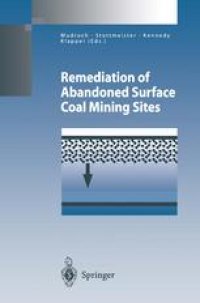
Ebook: Remediation of Abandoned Surface Coal Mining Sites: A NATO-Project
- Tags: Geotechnical Engineering & Applied Earth Sciences, Waste Management/Waste Technology, Terrestrial Pollution, Ecotoxicology
- Series: Environmental Engineering
- Year: 2002
- Publisher: Springer-Verlag Berlin Heidelberg
- Edition: 1
- Language: English
- pdf
Christopher Kennedy University of Toronto, Department of Civil Engineering, 35 St. George Street, Toronto, Ontario, Canada M5S IA4 Coal is a valuable resource. It provides a significant amount of the World's energy supply and it is the basis for many industries. However, in areas where coal lies close to the Earth's surface and has been exploited by open cast tech niques, radical alterations of landscape and significant impacts on the envi ronment have occurred. This report was prepared to provide guidance to those who are responsible for the prevention of environmental effects from surface mining and for the restoration of the mining areas. Environmental problems of surface coal mining and restoration of the mine sites are discussed in the re port. Particular attention is given to Eastern Europe, which continues to be a major centre of opencast lignite mining. Reclamation of mined lands for for estry, agriculture and wildlife is briefly discussed. However, the shear volume of coal removed from many mines in Eastern Europe is so vast, that there is often insufficient overburden material to refill the pits. Consequently, the main focus of this report is on the creation of lakes in these former surface mines. Many problems have to be overcome in creating healthy lakes for recreation or wildlife. Guidelines for treating water quality problems and further devel opment of lakes are provided. Techniques for dealing with acidic, waters, eutrophication and contamination are discussed.
The book describes the current state of former opencast mines in six countries. The remediation and reclamation of abandoned opencast mines are considered as a chance for new sustainable ecological, sociological and cultural developments in the regions concerned. The examples quoted from different countries allow the results of different remediation strategies to be compared. By way of conclusion, some recommendations are given at the end.